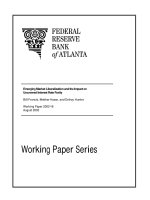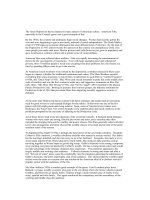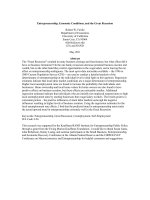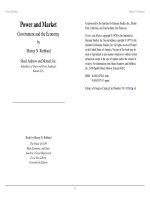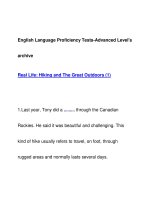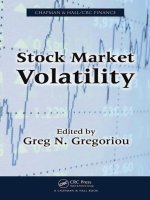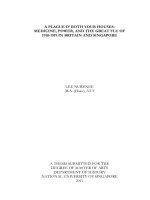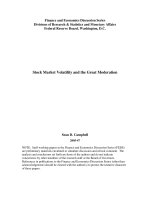Stock market volatility and the great moderation
Bạn đang xem bản rút gọn của tài liệu. Xem và tải ngay bản đầy đủ của tài liệu tại đây (533.69 KB, 50 trang )
Finance and Economics Discussion Series
Divisions of Research & Statistics and Monetary Affairs
Federal Reserve Board, Washington, D.C.
Stock Market Volatility and the Great Moderation
Sean D. Campbell
2005-47
NOTE: Staff working papers in the Finance and Economics Discussion Series (FEDS)
are preliminary materials circulated to stimulate discussion and critical comment. The
analysis and conclusions set forth are those of the authors and do not indicate
concurrence by other members of the research staff or the Board of Governors.
References in publications to the Finance and Economics Discussion Series (other than
acknowledgement) should be cleared with the author(s) to protect the tentative character
of these papers.
Stock Market Volatility and the Great Moderation
Sean D. Campbell
Board of Governors of the Federal Reserve System
August, 2005
Abstract: Using data on corporate profits forecasts from the Survey of Professional Forecasters, I
decompose real stock returns into a fundamental news component and a return news component
and analyze the effects of the Great Moderation on each. Empirically, the response of each
component of real stock returns to the Great Moderation has been quite different. The volatility
of fundamental news shocks has declined by 50% since the onset of the Great Moderation,
suggesting a strong link between underlying fundamentals and the broader macroeconomy.
Alternatively, the volatility of return news shocks has remained stable over the Great Moderation
period. Since the bulk of stock market volatility is attributable to return shocks, the Great
Moderation has not had a significant effect on stock return volatility. These empirical findings
are shown to be consistent with Campbell and Cochrane’s (1999) habit formation asset pricing
model. In the face of a large decline in consumption volatility, the volatility of fundamental
news shocks declines while the volatility of return shocks stagnate. Ultimately, the effect of a
Great Moderation in consumption volatility on overall stock return volatility in the habit
formation model is slight.
Keywords: Great Moderation, Stock Market Volatility, Fundamental News, Return News
Acknowledgements: I would like to thank Greg Duffee, Jim O’Brien, Matt Pritsker, Hao Zhou
and participants in the Board of Governors’ Finance Forum workshop for their comments. The
usual disclaimer applies. The views in this paper are solely the responsibility of the author and
should not be interpreted as reflecting the views of the Board of Governors of the Federal
Reserve System or of any person associated with the Federal Reserve System.
I. Introduction
One of the most prominent features of the U.S. economy over the past twenty years has
been the large and persistent decline in the volatility of macroeconomic activity. Across a wide
array of economic indicators including production, consumption and investment, the
macroeconomy has become more stable since the middle of the 1980's. While this “Great
Moderation” in macroeconomic volatility has been widely followed as it relates to real activity,
Kim and Nelson (1999), McConnell and Perez-Quiros (2000), Stock and Watson (2002,2003),
relatively little attention has been paid to its effects, empirically or theoretically, on the stock
market.1 In particular, how has the decline in macroeconomic volatility affected stock market
volatility to date and what are the likely consequences of the Great Moderation on stock market
volatility going forward?
In this paper I examine the effects of the Great Moderation on the volatility of the stock
market. My analysis is both empirical and theoretical. Following Campbell and Shiller (1988
a,b), I decompose real stock returns into a component that reflects news about future
fundamentals, i.e. earnings, dividends or cash flow, and a component that reflects news about
future returns and analyze the effects of the Great Moderation on each of these components.
I identify news about future fundamentals from forecasts of future NIPA corporate
profits after taxes from the Survey of Professional Forecasters (SPF). I then show that this
profits news series is directly related to real stock returns. Using the SPF profits news to
construct measures of fundamental and return news, I employ a structural break model to
examine how the Great Moderation affected the volatility of each of these news components. In
1
One notable exception to this point is the recent work of Lettau, Ludvigson and Wachter (2004).
1
the case of fundamental news, I find that the volatility of fundamental news declined
significantly and in concert with the general decline in broad macroeconomic volatility that
occurred in the middle of the 1980's. Over the period 1970-2005, I find that fundamental news
volatility declined by roughly 50% beginning in the fourth quarter of 1981. Accordingly,
fundamental news volatility is directly related to broader macroeconomic volatility. Return
news volatility, however, exhibited no significant decline over the Great Moderation period.
Consistent with previous research, Campbell (1991), Campbell and Vuolteenaho (2004), I find
that the bulk of stock return volatility is due to variability in return news rather than fundamental
news. Accordingly, the consequences of the Great Moderation on overall stock market volatility
have, thus far, been slight.
In order to better understand the effects of the Great Moderation on stock return
volatility, I examine the effect of a one-time, permanent decline in macroeconomic volatility on
stock return volatility within the context of a fully specified, consumption based asset pricing
model. Specifically, I examine the effect of a one time structural break in consumption volatility
within the context of Campbell and Cochrane’s (1999) habit formation asset pricing model
(CCH). Using model parameters consistent with observed financial market data and
consumption growth, I find that the effect of a Great Moderation sized decline in consumption
volatility on stock return volatility is consistent with the empirical findings. In the face of a
sharp decline in consumption growth volatility, fundamental news volatility declines
substantially while return news volatility and overall stock market volatility stagnate.
The disconnect between fundamental macroeconomic volatility and stock return
volatility stems from the fact that within the CCH model, the risk that investors are rewarded for
2
assuming is unrelated to long run consumption risk. Unlike more traditional asset pricing
models, such as the CCAPM, average Sharpe ratios and risk-free interest rates in the CCH
economy are unrelated to consumption growth volatility. Instead, investors are rewarded for
assuming what may be termed “habit risk”. Importantly, the volatility or riskiness of “habit risk”
is not related to the volatility of observable macroeconomic fundamentals such as consumption
growth. As a result, large changes in consumption growth volatility do not lead to any
significant decline in stock return volatility.
The contribution of this paper is two-fold. First, using a novel series on fundamental
news shocks which are shown to be directly linked to real stock returns, I document how the
Great Moderation has affected the volatility of stock returns. I document that the Great
Moderation has had very different effects on the volatility of fundamental news and return news.
The empirical analysis underscores the importance of analyzing fundamental news and return
news separately. The important link between fundamental news volatility and the Great
Moderation which I find would be completely obscured by a study that only examines the effect
of the Great Moderation on total stock return volatility. Second, I show that these empirical
results can be reconciled with a rational, consumption based asset pricing model. This finding is
important since traditional asset pricing models, such as the CCAPM, predict that a permanent
decline in fundamental volatility would ultimately result in a permanent decline in long run stock
return volatility. Accordingly, the disconnect between stock market volatility and fundamental
macroeconomic volatility need not be interpreted as a sign of market irrationality or as a general
failure of equilibrium asset pricing models. Finally, the agreement between the predictions of
the CCH model and the empirical results provides additional evidence on the importance of habit
3
formation like effects in explaining stock return behavior.
The remainder of this paper is organized as follows. Section II outlines the CampbellShiller stock return decomposition, discusses the data and the identification of the fundamental
and return news components of stock returns. Section III analyzes the volatility of real stock
returns and each of its components over the Great Moderation. Section IV examines the effect of
a one-time structural break in the volatility of consumption growth in the CCH model on stock
return volatility. The conclusion is presented in Section V.
II. Stock Returns, Expected Returns, Fundamental News and Return News
Decomposing Stock Returns
Campbell and Shiller (1988 a,b) and Campbell (1991) provide the following two
component decomposition of unexpected real stock returns,
,
,
(II.2)
where
refers to the growth in fundamentals,
period
and
, and
(II.1)
refers to the real stock return between
is a discount factor related to the long run level of the dividend
price ratio. The fundamental should be interpreted as the flow value of owning a share of stock.
Empirically, the fundamental is often identified with dividends but may also be associated with
earnings or even cash flow measures. This decomposition should be understood as an
accounting identity in which unexpectedly high prices either reflect high future fundamentals or
an increased willingness to hold stocks for the same expected stream of fundamentals (i.e. lower
returns). In this sense, unexpected returns can be thought of in terms of fundamental “news” and
4
return “news”.2
This decomposition leads to a natural framework for analyzing stock return volatility,
,
(II.3)
in which stock return volatility is caused by the volatility of fundamental news, the volatility of
return news and the covariance between the two. I construct a direct measure of fundamental
news from the NIPA corporate profits forecasts from the Survey of Professional Forecasters
(SPF). The Survey of Professional Forecasters is the oldest quarterly survey of macroeconomic
forecasters in the United States. The survey was originally conducted by the American
Statistical Association and the National Bureau of Economic Research. Since 1990, the survey
has been administered by the Federal Reserve Bank of Philadelphia.3 I then use these forecasts
to construct empirical measures of
and
and analyze how each element of the above
volatility decomposition has changed since the onset of the Great Moderation.
Beginning with Schwert (1989,1990), a variety of researchers have attempted to explain
the movements in stock return volatility over time with movements in the underlying
macroeconomy. Much of this work has concluded that there is no discernible link between
macroeconomic and stock market volatility. This analysis differs from these previous studies in
two main respects. First, these earlier studies typically examine how relatively high frequency,
i.e. monthly or quarterly, changes in stock market volatility are linked to the broader
2
Of course, another factor that could account for unexpectedly high returns today is the belief that prices
(and hence returns) will be unexpectedly high tomorrow. These kinds of self-fulfilling prophecies or “bubbles” are
ruled out in the above decomposition.
3
Croushore (1993), provides a detailed description of the SPF and surveys the academic literature as well as the
practical uses the survey has served since its inception in 1968.
5
macroeconomy. I focus on how a long-run, low frequency, arguably permanent change in the
macroeconomy has affected stock market volatility. Second, this analysis separates the
fundamental news component of stock returns from the return news component whereas much
previous research has focused on total stock market return volatility. Accordingly, this analysis
will allow for the fundamental and return news components of stock return volatility to react
differently to the Great Moderation. Ultimately, a contribution of this paper will be to document
how each component of stock return volatility has been affected by the onset of the Great
Moderation.
I use forecast data from the Survey of Professional Forecasters (SPF) to construct an
estimate of
. The SPF is a quarterly forecast of professional economic forecasters. I use
data between the third quarter of 1970 (1970:3) and the first quarter of 2005 (2005:1). Each
quarter the survey asks participants to forecast the level of a variety of macroeconomic variables.
In this paper, I identify the SPF forecast of NIPA corporate profits after taxes with fundamentals.
SPF Forecasts of the GDP deflator are used to construct forecasts of real corporate profits. The
survey asks participants to forecast the level of NIPA corporate profits after taxes, and the GDP
deflator, for the current quarter and each additional quarter over the next four quarters. I
aggregate forecasts from different survey respondents within the SPF by selecting the median
forecast at each date. This data on forecasted levels is then used to construct implied forecasts
of growth rates. The growth rate forecasts from two adjacent quarters are then used to construct
the implied revisions,
,
(II.4)
6
where
is defined as the level of real NIPA corporate profits. I then compute the weighted
average revisions to these real growth forecasts at each point in time,
,
which I use as a proxy for
(II.5)
. I use a value of 0.99 for
in the case of quarterly data
which is consistent with the long run average level of the dividend-price ratio.
The data on the fundamental news series,
series,
, and each of the three revision
, is summarized in Figure I and Table I. Figure I contains a time series plot
of the constructed fundamental news series and Table I presents selected summary statistics for
the fundamental news series and each of the revision series over the sample period, 1970:3
through 2005:1. The NBER recession dates are superimposed on the plot in Figure I for
reference.
Looking at Figure I, fundamental news does appear to correspond with movements in the
business cycle. In particular, fundamental news tends to be negative or declining during NBER
recessionary periods. Looking at the summary statistics in Table I reveals that the revisions to
SPF forecasts are roughly mean zero, indicating that the forecasters are not consistently surprised
in the same direction. The standard deviation of forecast revisions declines as the horizon of the
forecast lengthens. The standard deviation of forecast revisions pertaining to corporate profits
growth in period
pertaining to period
is roughly 20% larger than the standard deviation of revisions to forecasts
suggesting that forecasters’ beliefs about the long term are more stable
than their beliefs about the near term. Interestingly, each of the revision series and the
7
fundamental news series exhibits excess kurtosis, which underscores the fact that relatively large
revisions in either direction are not too uncommon. In particular, periods surrounding NBER
recession dates often exhibit large upward and downward revisions to future forecasts of
corporate profits.
Assessing the Quality of
While the constructed fundamental news series,
, is related to the actual
expectations of professional forecasters, that is no guarantee that it is an accurate measure of the
true but unobserved fundamental news shock,
. If the forecasts are extremely poor and
unreliable then they may not provide much of a signal about the future path of stock market
fundamentals and may be largely ignored by the stock market. In order to assess the quality of
this fundamental news measure, I examine the information content of the SPF forecasts along
two separate dimensions. First, I examine whether SPF corporate profit forecasts are informative
for future corporate profit realizations. Second, I examine whether the stock market reacts to
the news contained in the SPF forecasts.
In order to argue that changes in the SPF forecasts reflect fundamental news it must be
the case that the forecasts themselves are relevant for understanding movements in actual
corporate profits. I measure the information content of SPF corporate earnings forecasts by
estimating the system,
,
(II.6)
8
where
represents real growth in NIPA corporate profits after taxes between quarter
and
and
represents the corresponding SPF forecast. The system is estimated via
an exactly identified GMM system using Newey-West estimates of the optimal weighting
matrix. The estimation results are contained in Table II.
Before examining the information content of the SPF forecasts, it is useful to have an
idea of how forecastable corporate profits are from a simple time series model. I estimate an
AR(1) model for the growth in real NIPA corporate profits after taxes using the entire sample
period, 1970:3 - 2005:1, for estimation. I use an AR(1) because it is parsimonious and
represents a reasonable benchmark model against which other forecasts can be compared.4 The
first order autoregressive coefficient is estimated to be 0.19, indicating little persistence in the
growth rate of corporate profits. This estimate translates into an
of one step ahead forecasts
of only 3.3%. Autoregressive forecasts at more distant horizons are even less accurate. The
implied
of forecasts beyond one quarter are all less than 1%.
Turning to the results contained in Table II indicates that the SPF forecasts represent a
considerable improvement over and above the time series model. Each row of Table II contains
the estimates of
and
along with their standard errors and the associated regression
.
Looking at the top row of Table II, one quarter ahead SPF forecasts have significant information
content for future corporate profit growth. Specifically, the one quarter ahead SPF forecasts
explain roughly 10% of the variation in NIPA corporate profits and the associated estimate of
4
Given the quarterly nature of the data, one might suggest that an AR(4) is a more reasonable benchmark.
Using an AR(4) boosts the
of one step ahead forecasts from 3.3% to 4.9%.
9
is large and significant (0.77).5 As the forecast horizon lengthens, the information content of
the SPF forecasts naturally decline. At the two and three quarter ahead horizons, SPF forecasts
explain a little more than 2% of the variation in corporate earnings and the associated estimates
of
and
are smaller (0.45 and 0.57) and less significant. The forecasts, however, especially
in the case of two quarter ahead forecasts are informative about future profits when compared to
the benchmark AR(1) model. SPF forecasts of corporate earnings four quarters ahead have little
ability to account for future earnings growth since they explain less than 1% of the variation in
corporate profitability. Taken together, these results indicate that SPF forecasts are a useful
source of information about future movements in corporate profits. The forecasts are more
informative at shorter forecast horizons but are significantly more informative than forecasts
from a benchmark AR(1) model.
Aside from the question of how informative or accurate SPF forecasts are for future
corporate profits, it is also important to examine the extent to which the stock market reacts to
the news contained in these forecasts. This provides a market test of the SPF forecasts’
applicability as a measure of fundamental news. In particular, even if SPF forecasts were
excellent predictors of future earnings growth, if the stock market did not react to innovations in
the forecasts it would be difficult to interpret the forecasts as a source of fundamental news.
5
One can argue that the
from the time series model should only be compared with that computed from
the forecast error,
, and not the regression
from Table II. Two points are worth noting. First,
doing so lowers the
from 10.2% to 9.3% in the case of the one step ahead forecasts. Second, Elliott, Kommunjer
and Timmerman (2004) point out that the elicited forecast only has the interpretation of a conditional mean under
quadratic loss. In the case that professional forecasters’ loss functions are not quadratic, interpreting as a
conditional mean is problematic and the
from Table II may be a better measure of the forecast’s information
content than is the
computed from . Moreover, in the case that the elicited forecast,
, is a scaled version of
the conditional mean,
, it can still be informative about the revision process,
10
.
Recall from the Campbell-Shiller decomposition of unexpected stock returns that,
,
so that in the event that return news is uncorrelated with fundamental news, the population
regression coefficient from regressing
onto
is unity. In order to assess the degree to
which the SPF expectation revisions are linked to real returns, I regress quarterly, real stock
returns on the CRSP value-weighted portfolio,
, onto
as well as each of its constituent
.6 The regression slope coefficients,
components,
standard errors and adjusted
are contained in Table III. Table III contains the results from
regressing each fundamental news measure onto real returns separately as well as the results
from regressing all three measures onto the real return series.
First, consider the reaction of the stock market to the individual SPF forecast revisions.
In the case of the first two revisions,
, real stock returns react
strongly and significantly to changes in these profit forecasts. In both cases the point estimate of
the slope coefficient is slightly larger than one (1.28 ans 1.13) and highly significant. As the
length of the forecasting horizon increases the reaction of the stock market to forecast revisions
decreases. The reaction of real stock returns to the most distant SPF forecast
revisions,
, is the smallest (0.40) and insignificant. Overall, however, real stock
returns do react significantly to SPF forecast innovations as expected. This is best seen by
6
Returns are deflated using the CPI-U as a deflator.
11
examining the relationship between real returns and the measure of fundamental news,
.
Positive fundamental news significantly increases real stock returns as evidenced by the large,
positive and significant slope estimate (0.68). It is also interesting to note that the fundamental
news measure summarizes well the information contained in all three revision series. The
adjusted
in the regression of real returns on
is larger than in any of the univariate
regressions or the multiple regression that uses each revision separately to explain real stock
returns.
The regression
indicates that fundamental news accounts for a little more than 7% of
the variance in real stock returns over the sample period. This finding suggests that variation in
expected returns and return news dominates the effect of fundamental news in determining real
returns. While the amount of real return variation explained by fundamental news is small, this
finding is not unexpected. Previous studies linking movements in the stock market to
movements in fundamentals and movements in rates of return also find that movements in
fundamentals only explain a modest portion of stock return variability. Campbell (1991), for
example, finds that between 1952 and 1998, fundamental news explains between 8.5% to 10.0%
of the variance in stock returns. Recent studies by Bernanke and Kuttner (2004) as well as
Campbell and Vuolteenaho (2004), find similar results. Accordingly, the fact that the
constructed fundamental news series only explains around 7% of the variation in real stock
returns is consistent with the literature on the relation between fundamentals and stock returns.
In what follows, the revisions to SPF forecasts are used in conjunction with real stock
returns to construct an estimate of the two components of real stock returns that are related to
12
expected returns and fundamentals. Namely, I construct the variables,
(II.7)
.7
(II.8)
Note that I do not take a stand on a model of expected returns to identify
separately from
. This modeling choice is motivated by two considerations. First, there is much debate
and little agreement over what set of variables reliably predict stock returns. Second, much
empirical evidence indicates that the volatility of news to future returns dominates the volatility
of expected returns. As a result, the gain from directly modeling expected returns is likely to be
small. In what follows, I will use the term “return news” to refer to the term
estimate,
estimate
or its
. Similarly the term “fundamental news ” will refer to
or its
.
III. The Great Moderation and Stock Return Volatility: Fundamental and Return News
Structural Break Analysis
In order to assess the degree to which the three components of stock market volatility
7
Note that in defining
, I subtract
from
rather than
where is the OLS
slope estimate from Table III. One might reasonably prefer the latter. Since, however, the variance of
is dominated by the variance of real returns, it makes little difference in the empirical analysis which way
is constructed.
13
were affected by the Great Moderation, I examine the evidence in favor of a structural break in
,
and
. Much of the literature on the Great Moderation has
interpreted the broad decline in the volatility of aggregate output, consumption, investment and
other macroeconomic aggregates as a permanent phenomenon. This has led previous researchers
to employ econometric tests of a single structural break as a means of testing for and
characterizing the size of the Great Moderation. Stock and Watson (2002) and McConnell and
Perez-Quiros (2000), for example, both employ single structural break tests in measuring the size
and significance of the Great Moderation. I employ a similar structural break test to remain
consistent with the permanent interpretation of the Great Moderation.
The structural break volatility model is specified is as follows,
,
(III.1a)
,
where
represents either
(III.1b)
or
and the exponential model is employed to
account for the positivity of the absolute value. In order to assess the evidence in favor of a
structural break in the covariance between return news and fundamental news, I estimate the
structural break model,
,
.
In each case the break date,
(III.1c)
(III.1d)
, must be constrained to lie away from the sample’s endpoints in
order to appeal to the asymptotic theory underlying the test. I selected the boundary points for
14
the break date following Andrews’ (1993) suggestion of using the middle 70% of the sample
period. The model is estimated for each possible break date within the boundary points by
GMM and the test statistic is defined to be the maximum Wald statistic over all possible break
dates of the null hypothesis that
this test statistic,
. Andrews (1993) provides the asymptotic distribution of
, under the null of no structural break. Using the boundary points referred
to above, the critical values of the test at the 10%, 5% and 1% level are 7.17, 8.85 and 12.35,
respectively.
I present the estimated break date, break size and its statistical significance in Table IV.
In Figure II, I display the value of the Wald statistic for each possible break date along with the
cutoff value for significance at the 10%, 5% and 1% level for each of the three tests. These plots
can be used to construct a confidence interval for the break date.
Looking at Figure II and Table IV the case for a permanent change in the volatility of
fundamental news, return news or the covariance between the two is strongest in the case of
fundamental news. In the case of fundamental news the structural break test is significant at a
level in between 1% and 5%. The estimated structural break parameter implies that the volatility
of fundamental news abated by roughly 50%. This is a large decline in volatility but generally in
line with the kind of volatility reduction that was experienced by other macroeconomic
aggregates over this period. As an example, Stock and Watson (2003) find that the volatility of
consumption and GDP growth declined by 40% after the onset of the Great Moderation. The
estimated break date of 1981:4 is also largely consistent with the timing of the Great Moderation.
While different authors use different dates for the Great Moderation all agree that the large
volatility decline occurred sometime in the early to mid-1980's. The case for a structural break
15
in the volatility of return news or the covariance between return news and fundamental news is
much weaker. While the estimated break date is within reason in both cases the test statistic is
well below the 10% critical value.
The results of the structural break tests indicate that the Great Moderation has affected
the volatility of fundamental news shocks. The structural break analysis suggests that the
volatility of fundamental news declined by roughly 50% since the onset of the Great Moderation.
In this sense, stock market volatility is related to macroeconomic volatility. Both
macroeconomic volatility and the volatility of fundamental news have declined in concert. The
strong link between macroeconomic volatility and fundamental news volatility, however, does
not carry over to return news. Since the volatility of fundamental news is small relative to the
volatility of return news, the Great Moderation did not exhibit a large influence on overall stock
return volatility.
These findings raise questions about how the fundamental news and return news
components of stock returns could react so differently to the same underlying structural change
in the macroeconomy. In what follows, I examine the effect the Great Moderation would have
from the perspective of Campbell and Cochrane’s (1999) habit formation asset pricing model.
Using this model, I show that the apparent disconnect between fundamental news volatility and
future return news volatility is entirely consistent with Campbell and Cochrane’s (1999) habit
formation model. This finding is further contrasted with the prediction of the traditional
CCAPM which predicts that a permanent decline in fundamental volatility would ultimately
result in a decline in stock return volatility.
16
IV. The Implications of the Great Moderation for Stock Market Volatility: An Asset
Pricing Model With Habit Formation
Motivation for the Modeling Framework
The main empirical finding of this paper is that while the volatility of fundamental news
has declined in response to the Great Moderation, the volatility of return news has not. From the
perspective of the Campbell-Shiller decomposition,
,
the volatility of return news,
, has not been materially influenced by the large, abrupt and
arguably permanent drop in macroeconomic volatility since the middle of the 1980's. In this
section, I examine the influence of the Great Moderation on the different components of stock
return volatility through the lens of Campbell and Cochrane’s (1999) habit formation asset
pricing model (CCH). Specifically, I employ the CCH model and examine the effect of a one
time structural break in the volatility of consumption growth on the volatility of the different
components of real stock returns.
I choose to investigate the theoretical link between the volatility of fundamentals and
return news with the CCH model for two reasons. First, as an asset pricing model, CCH is
explicitly dynamic allowing for rich time variation in expected rates of return and hence provides
a substantive role for
. In particular, even in an economy in which the distribution of
fundamentals, i.e. consumption or dividend growth, is fixed CCH delivers time variation in
expected rates of return. More traditional asset pricing models, such as the CCAPM, imply a
fixed rate of return when the distribution of fundamentals is fixed. As a result, absent any time
17
variation in the distribution of fundamentals, these models imply that return news,
, is
identically zero. Time variation in expected rates of return can be added to these models by
introducing time variation in the distribution of fundamentals but these models then imply that
this is the only source of variation in expected rates of return. Since empirical evidence suggests
that time variation in expected rates of return, i.e.
, is the main driver of stock return
volatility both before and after the onset of the Great Moderation, assuming that the Great
Moderation is the sole source of variation in expected rates of return is somewhat problematic.8
Alternatively, the richness of CCH implies that a variety of factors influence expected returns
and hence
. As a result the CCH model provides a framework for disentangling the
importance of fundamental volatility relative to all other factors that drive expected returns.
Second, the CCH model is one of the few consumption based, rational asset pricing
models that captures a variety of stylized features of the U.S. stock market that have bedeviled
more traditional consumption based models for more than thirty years. In particular, CCH
delivers expected rates of return, risk free rates and Sharpe ratios that are consistent with
observed data. The large literature on the failure of the prototypical consumption based model,
i.e. the CCAPM, has shown that this model is largely unable to account for even the most
fundamental features of U.S. stock returns. Before conducting an analysis of the link between the
volatility of macroeconomic fundamentals and the volatility of stock returns it is desirable to
8
There are variants of the CCAPM that do allow for time variation in expected rates of return through time
variation in the market risk premium. Lettau and Ludvigson (2001), for example, introduce time varying risk premia
to the CCAPM. These models, however, are empirical and do not provide an equilibrium mapping between the
distribution of fundamentals and risk premia. As a result, it is not possible to examine the implications of the Great
Moderation within the context of these models.
18
work with a model that can successfully account for the more basic features of U.S. stock
returns.
Before describing the model and how it behaves in the event of a Great Moderation in
consumption volatility, it is useful to point out the related work of Lettau, Ludvigson and
Wachter (2004) on the links between the stock market and the Great Moderation, as it is one of
the only other papers that assesses the effects of the Great Moderation on the stock market.
Their work differs from mine in several respects. First and foremost, Lettau, Ludvigson and
Wachter (2004) focus on the level of asset prices and not their volatility. Specifically, they focus
on whether or not the Great Moderation could account for the large run up in the level of stock
prices observed over the 1990's.
Also, their modeling strategy is considerably different from mine. There are three key
differences between our modeling strategies. First, they employ the CCAPM as their structural
model and I employ Campbell and Cochrane’s (1999) habit formation model. Second, they
model the Great Moderation as a transitory event in the sense that there is always a positive
probability of returning to a lower volatility regime. I follow the bulk of the Great Moderation
literature in interpreting the Great Moderation as a one time permanent decline in the volatility
of consumption growth. Lettau, Ludvigson and Wachter (2004) also model the volatility regime
as a hidden state that must be inferred from the observed history of consumption growth. In this
sense, learning plays a crucial role in their framework. I abstract from the effects of learning by
assuming that the structural break in fundamental volatility is observed immediately once it
occurs. Ultimately, the results of the analysis will suggest that including a learning process
would not materially change the predictions of the CCH model.
19
In what follows, I provide a brief description of the CCH model, how asset returns are
determined within the model and then I discuss how a one time break in the volatility of
consumption growth would affect the volatility of stock returns and its constituent components,
and
.
The Campbell & Cochrane (1999) Habit Formation Model
The CCH model is a representative agent, complete markets endowment economy.
Below, I briefly describe the technology and preferences of the economy. The description
presented here is brief. Readers are referred to Campbell and Cochrane (1999) for a more
detailed description of the model.
Consumption growth is modeled as an exogenous process. The statistical model assumes
that log consumption follows a random walk with i.i.d. normally distributed shocks,
where
,
(IV.1a)
,
(IV.1b)
represents the economy’s long-run growth rate and
represents the level of uncertainty
surrounding future consumption. Since consumption is the only observable economic quantity
that relates to the broader macroeconomy, I consider the Great Moderation to be reflected in a
one time change in
.
At this point it might be argued that the assumption on the consumption growth process
is inconsistent with the observed data from the SPF. In particular, if consumption, and
20
ultimately earnings and dividend, growth were i.i.d. then expectational terms of the form,
,
would be identically zero whereas the SPF clearly shows that these revisions to expectations are
non-zero. Importantly, however, CCH still provides a channel for fundamental news. In
particular, fundamental news is operative through the term
which is non-zero in
the CCH model. A richer structure for revisions to expected future fundamentals could be
obtained within the CCH model by assuming an autoregressive structure for consumption
growth. While a variant of the CCH model in which consumption growth is autocorrelated
would be of interest, the substance of the analysis presented here would not be materially
affected by this change in the model’s structure.
Preferences in the CCH model are additively separable across time with discount factor,
. The model’s main departure from the standard consumption based model is in the
specification of per-period preferences,
. In particular, each period, the investor’s utility is
defined with respect to a reference level of consumption,
. Preferences take the form,
,
(IV.2)
so that risk aversion is time varying. The coefficient of relative risk aversion,
,
21
, takes the form,
where
is defined to be the “surplus consumption ratio”. The reference level of
consumption,
, is modeled as an external habit in the sense that the agent takes the reference
level as given and does not impute the effect of current choices on the future reference level.
Rather than model the evolution of the reference level directly, as in Constandinides (1990) for
example, a transformation of external habit, the log surplus consumption ratio is modeled as a
heteroskedastic, autoregressive process that reacts to shocks to consumption growth as follows,
,
(IV.3)
where lowercase letters refer to logarithms of their uppercase counterparts. How the log surplus
consumption ratio,
, responds to consumption shocks is governed by the sensitivity function,
. Importantly, note that the sensitivity of the future level of the log surplus consumption
ratio depends on its current level. The model for preferences is completed by specifying a
functional form for the sensitivity function.
Campbell and Cochrane (1999) require that the sensitivity function meet three separate
criteria: (1) real interest rates are a linear function of the log surplus consumption ratio; (2) the
reference level of consumption,
, is pre-determined in the steady state so that,
; and (3) the reference level of consumption always moves non-negatively with
22
, when
consumption. These three considerations yield the following specification of the sensitivity
function,
,
(IV.4a)
,
(IV.4b)
,
where
(IV.4c)
is a bound on the log surplus consumption ratio that ensures the sensitivity function
always remains positive and
is the steady state value of the log surplus consumption ratio.
The Investment Opportunity Set in the Campbell-Cochrane Habit Formation Model
Before turning to an analysis of how changes in consumption volatility will affect stock
market volatility, it is useful to characterize the investment opportunity set in the CCH model.
An understanding of how macroeconomic risk affects the investment opportunity set will
provide some insight into how changing macroeconomic risk will affect the volatility of stock
returns. In order to have intuition for how macroeconomic risk affects the investment
opportunity set it is useful to consider how macroeconomic risk affects the model’s stochastic
discount factor (SDF).
The stochastic discount factor in the CCH model takes the particularly simple form,
23
